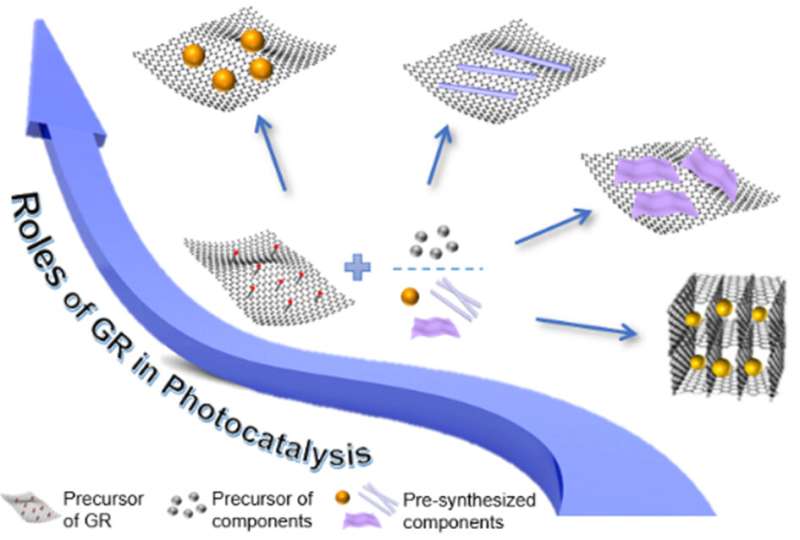This review overviews optimizing strategies and synthesis of graphene-based composite photocatalysts oriented by the fundamental manifold roles of graphene in photocatalysis and proposes the key challenges and future perspectives for further investigations of graphene-based photocatalysts. Credit: Chinese Journal of Catalysis
Graphene (GR), a single-layer carbon sheet with a hexagonal packed lattice structure, has displayed attractive potential in artificial photocatalysis due to its enchanting properties in enhancing light absorption, electron transfer dynamics, and surface reactions. Nowadays, multifunctional GR-based photocatalysts, such as GR-semiconductor, GR-metal, and GR-organics have been widely employed in photocatalytic water splitting, environmental purification, carbon dioxide reduction, and selective organic synthesis to provide a viable and sustainable strategy to the problems of energy shortage and environmental crisis. Owing to the unique and fascinating features of ideal GR, including 2D flat structure, high theoretical specific surface area, superior optical transmittance, excellent electron conductivity, and good chemical stability, GR has been considered as a promising cocatalyst to enhance the conversion efficiency of solar energy of artificial photosynthesis systems. Besides, in some specific photocatalytic systems, GR also is able to act as the macromolecular photosensitizer to generate photoelectrons by itself.
As is well known, choosing appropriate synthesis method plays a significant role in tailoring the properties of GR-based composites, such as morphology, size, defect structure, and surface/interface properties, which are closely linked to their photocatalytic performance. Hence, enormous efforts have been devoted to exploring and optimizing synthesis methods, such as hydrothermal/solvothermal method, combustion treatment, low-temperature oil bath method, sol-gel approach, ultrasonication-assisted deposition, microwave-assisted synthesis, photo-assisted reduction, electrochemical deposition to construct high-efficiency GR-based composites with desirable architecture.
Recently, a research team led by Prof. Yi-Jun Xu from Fuzhou University, China critically overviewed the optimization strategies and synthesis of multifunctional GR-based composite photocatalysts. The optimization strategies of GR-based composites are firstly introduced, such as decreasing the defect density of GR, chemical doping, optimizing the dimensionality of GR and photoactive components, depositing cocatalysts to construct dual- or multi- cocatalysts systems and optimizing interfacial parameters of GR-based composites. Then, the synthesis of GR-based composites is discussed from a new perspective, which is oriented by the roles of GR in photocatalysis, containing photoelectron mediator and acceptor, improving adsorption capacity, tailoring light absorption range and intensity and macromolecular photosensitizer. Beyond that, a brief outlook on the challenges and potential evolution strategies for enhancing the solar energy conversion efficiency of GR-based composites are proposed. The review was published in Chinese Journal of Catalysis.
More information: Yue-Hua Li et al, Multifunctional graphene-based composite photocatalysts oriented by multifaced roles of graphene in photocatalysis, Chinese Journal of Catalysis (2022). DOI: 10.1016/S1872-2067(21)63871-8
Provided by Chinese Academy of Sciences
























